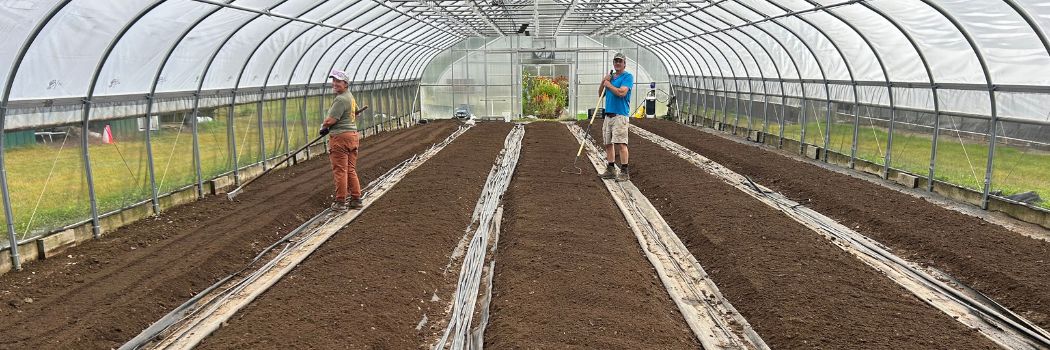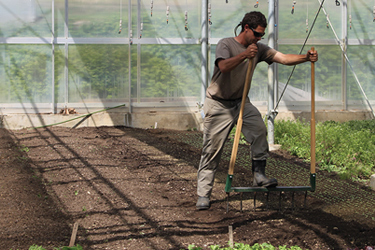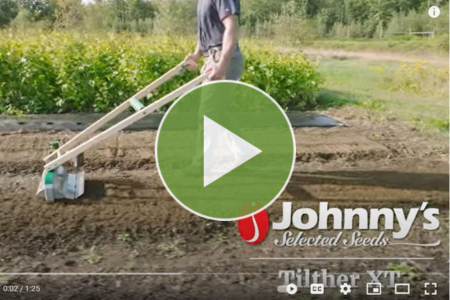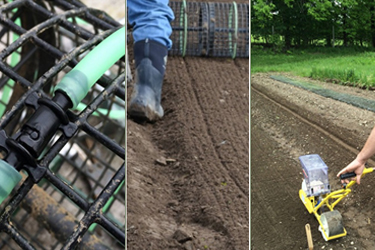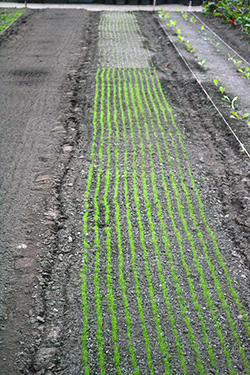- Adjustable Toolbar | Assembly & Use Instructions | Tech Sheet (PDF)
- Tilther XT | Johnny's Selected Seeds
- Bed Preparation Rake | Assembly Instructions | Tech Sheet (PDF)
- Broadfork Applications | Comparison Chart (PDF)
- Johnny's Broadforks | Assembly & Usage | Tech Sheet (PDF)
- Eliot Coleman's 6-Step Bed Preparation Method
- Flame Weeder | Assembly, Backpack Tank Mounting, Usage & Safety Instructions | Tech Sheet (PDF)
- Connecta® Matrix Row Marker | Assembly & Instruction Manual (PDF)
- Hanna pH Meter Instructions | Tech Sheet (PDF)
- A Brief History of Tool Development at Johnny's | Planting the Seed of a Small-Scale Farming Revolution
- Infinite Rolling Dibblers | Comparison Chart (PDF)
- Manual Mulch Layer | Instructions for Assembly & Use | Tech Sheet (PDF)
- Mulch Hole Burner | Instructions for Use | Tech Sheet (PDF)
- Metallic Silver Mulch Instructions | Tech Sheet (PDF)
- White-on-Black Mulch Instructions | Tech Sheet (PDF)
- Mulches & Landscape Fabrics | Comparison Chart (PDF)
- Solar Shrink® | Instructional Label (PDF)
- Staple Pro 1011 Staple Driver | Use & Maintenance | Tech Sheet (PDF)
- Double Rolling Dibbler | Instructions for Assembly & Use | Tech Sheet (PDF)
- Infinite Rolling Dibbler | Instructions for Assembly & Use | Tech Sheet (PDF)
- Two-Person Infinite Rolling Dibbler | Instructions for Assembly & Use | Tech Sheet (PDF)
- Single Rolling Dibbler | Instructions for Assembly & Use | Tech Sheet (PDF)
- Johnny's Guide to Small-Scale Bed Preparation Tools
- Soil Thermometer Instructions | Tech Sheet (PDF)
- Solar Mulch Instructions | Tech Sheet (PDF)
- Johnny's Seedbed Roller | Assembly Instructions & Use | Tech Sheet (PDF)
- Seedbed Roller Snap-In Dibbles | Instructions for Use | Tech Sheet (PDF)
- SRM-Red | Selective Reflecting Mulch Instructions | Tech Sheet (PDF)
- Tilther | Instructions for Use | Tech Sheet (PDF)
- Video: Using Row Markers with Johnny's Seedbed Roller
- Video: Staple Setter™ | Drive Staples into Landscape Fabric, Fast & Easy
- Video: Manual Mulch Layer | Quickly Lay Mulch with this People-Powered Tool
- Video: Johnny's Tilther | The Eliot Coleman-designed bed-prep tool
- Video: Seedbed Roller Demonstration, with Row Markers & Snap-In Dibble Accessories
- Video: Johnny's Mulch Hole Burner | Accurately Burn Holes in Mulch or Landscape Fabric
- Video: Eliot Coleman Talks about the Development of the Tilther
- Video: Using the Tilther | Designed by Eliot Coleman for Johnny's Selected Seeds
- Video: Johnny's Flame-Weeder Demonstration
- Video: Johnny's Broadforks | Redeveloped from a European design by Eliot Coleman
- Video: How to Use & Handle a Silage Tarp to Create a Stale Seed Bed
- Tilther XT | Assembly & Instruction Manual (PDF)
- Replacement Instructions for the Tilther Tine Shaft ⅝" Ball Bearings | Tech Sheet (PDF)
- Replacement Instructions for the Tilther Drive Shaft ½" Ball Bearings | Tech Sheet (PDF)
- Connecta® Bed Prep Rake | Connecta Tool System
- Carrot Growing Guide | Fundamentals of Bed Preparation, Spacing, Weeding & Watering - Part 1
A Guide to Johnny's Small-Scale Bed Preparation Tools
For Small-Scale Commercial Growers & Avid Home Gardeners
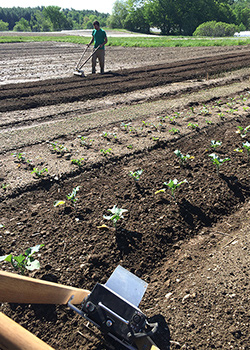
Over the years, Johnny's has developed and brought into the offering a robust line of bed prep tools that boost efficiency for smaller-scale growers and home gardeners.
Not every grower's situation will call for every tool in this overview, but here is how these tools can be used when the problem seeks a solution.
Note: The recommendations in this article are for beds that are ready and waiting for hands-on preparation. If you're battling a prodigious weed seed bank, you may want to plan some form of preemptive weed suppression. Opaque silage tarps and flame-weeding can both be used to create a stale seed bed in advance of planting. These methods are sometimes applied following initial native bed preparation, and tarping can also be used to reclaim fallow, grassy, or weedy areas prior beforehand.
1 • Loosening the Soil
Loosening the soil with a broadfork is an efficient and ergonomic way to improve its aeration without having a detrimental effect on its structure. Good aeration is almost invariably good for soil that is intended for growing crops.
Johnny's Broadforks
These are deep-aerating tools designed long ago in Europe and subsequently redeveloped by Eliot Coleman and Johnny's. Our Broadforks are designed to deeply aerate while preserving soil structure and minimizing the surfacing of weed seeds.
Multiple sizes are available to match your strength and comfort level and the task at hand. Models are available in the traditional round-tine design as well as our Hardpan Broadforks, with chisel-shaped tines designed for tougher soils.
To use, gently hop on the tool and use your weight to drive the full length of the tines into the ground. Hop off and rake the handles back just enough to crack the soil (about 45°), lifting it and introducing air. Repeat this action at a spacing approximately the length of the tines (every 8"–10" or so), working backwards with the tool to avoid compaction. The ease and rhythm with which this can be accomplished will vary with soil conditions. The broadfork will reveal and lift rocks, but the rocks should be removed with a shovel.
2 • Amending as Appropriate
Incorporating amendments and improving "tilth," or the "crumb" of your soil, may be an appropriate step, depending on your situation.
The Tilther XT
Conceptualized by Eliot Coleman and used extensively on his farm in Maine, the Tilther is a lightweight tiller powered by a rechargeable drill and designed to create perfect tilth within the top inch or two of your bed by mixing in compost and fertilizer while chopping up any fine debris remaining after clean-up of the previous crop. Our Tilther has been a customer favorite since we introduced it in 2005. The Tilther XT is an improved version of the Johnny's original, boasting upgrades backed by grower feedback and our own trial observations.
If you have one of these on hand, it is very convenient to make one pass down each side of the bed top, to really work up the soil in that topmost layer and incorporate amendments you will be using. Amending the soil at this stage with the Tilther can be more efficient than adding inputs during earlier or initial tillage of native ground, as smaller quantities can be allocated directly where the crops will be growing, not in the footpaths.
3 • Leveling, Smoothing & Firming the Bed
Smoothing and leveling the bed top helps assure successful seeding.
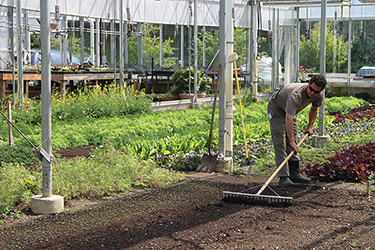
Bed Preparation Rake
At this point, the bed top is raked smooth to create a perfect seedbed for successful precision planting. A Bed Prep Rake is a perfect tool for that—an excellent companion to precision seeders.
This Eliot Coleman favorite is so light that the user can support its entire weight, even when fully extended. Its teeth grab stones and debris when pulled, then level and smooth the bed when pushed. Its handle allows the user to reach way out, but still "float" the rake to achieve a nice, flat bed top.
If you are transplanting, you might skip this step, or skip the step above with the Tilther.
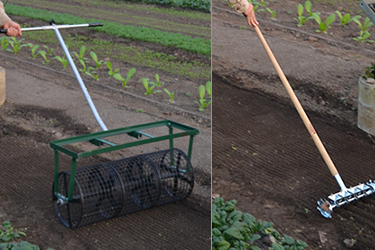
Firming the bed beforehand is highly recommended when seeding with the Pinpoint Seeders or Six-Row Seeder.
Seedbed Roller
Seedbed rollers can be used to prepare a smooth, firm surface for direct seeding or transplanting. The perfect complement to precision seeders and mechanical harvesters, Johnny's Seedbed Roller is fitted with heavy-duty lobster trap wire mesh. Its 1" spacing is close enough to break up smaller clumps and dirt clods but wide enough to resist getting clogged with soil and mud.
The Seedbed Roller can also be used post-seeding, to press seed firmly into contact with the soil for improved germination rates. The implement's design permits it to be either pulled or pushed, and the handle is adjustable laterally to allow operation in-row or from either footpath. A metal rack fitted over the top can accommodate additional weighting if needed.
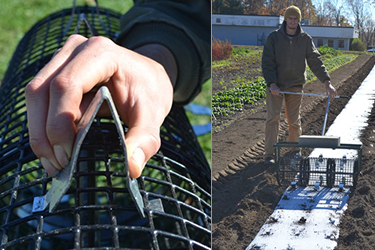
Snap-in Dibbles for the Seedbed Roller
Available in three sizes and easily interchangeable, the Snap-in Dibbles allow for numerous combinations of plant spacings, with perfect spacing every time.
The Seedbed Roller's 1" mesh and 36" circumference make dibble arrangement simple and intuitive. No special tools required; just squeeze the ends and they snap right in, securely gripping the coated trap wire mesh from both inside and out. Change-out for new setups is fast and easy. The Dibbles work as well through plastic mulch as they do in open soil — sometimes better, contingent upon soil moisture level.
Depending on soil conditions, additional weight may be necessary to achieve full dibble penetration. If additional weight is needed, the roller is more easily pulled than pushed.
Row Markers for the Seedbed Roller
The Seedbed Roller's 1" mesh makes arrangement of the Row Markers easy, allowing you to mark perfectly-spaced rows for seeding while you roll the bed.
The Row Markers are fashioned of 5/16"-diameter polyethylene tubing with plastic quick-disconnects that can be readily installed around the Seedbed Roller to mark rows for seeding with a single-row seeder. (Some minor assembly is required.)
4 • For Succession Plantings
Preparing existing beds for mid-season succession plantings is basically a short-form version of the procedure outlined above.
Tilling is typically not necessary, but aeration with a Broadfork is almost invariably a good idea.
If you have raised beds, they may need to be reformed if they have settled a lot due to weather or other forces of compaction.
The rest of the bed-prep elements above fall into line next as you prepare the bed: use the Tilther XT to fluff and even the bed top and incorporate any needed amendments; a Bed Prep Rake to level and smooth; the Seedbed Roller to firm; Dibbles and Row Markers if necessary; and so forth.
5 • Laying Mulch
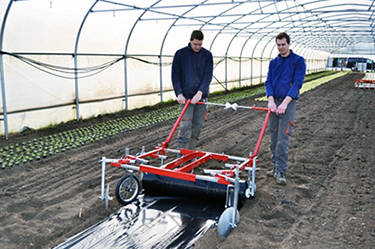
This hand-pulled device makes laying plastic mulch on the soil faster and easier.
Unless you have a tractor-mounted mulch layer, this step can be a labor-intensive process. Here is an alternative solution — a novel product that is "people-powered."
Manual Mulch Layer
Quickly and efficiently lay mulch by hand with this manually operated device. Fully adjustable for a wide variety of bed widths and mulch sizes, this hand-powered mulch layer can be a real game-changer. Designed for maneuverability, it can be useful in greenhouses, high tunnels, or areas where field space is limited.
One of the greatest features of the Manual Mulch Layer is that it can concurrently lay single or multiple lines of drip tape. For precise placement, optional Drip Tape Collar Stops can be fitted. The Manual Mulch Layer accommodates 36–60" mulch widths, weighs 97 pounds, and requires some assembly.
Laying mulch with this tool is a two-person operation. For added convenience, optional Transport Wheels can be attached.


